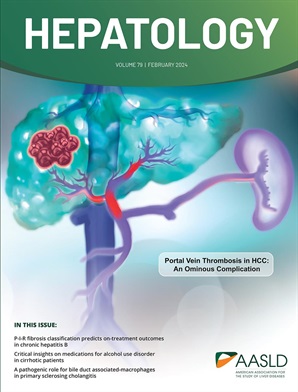Prediction models for liver decompensation in compensated advanced chronic liver disease: a systematic review
IF 12.9
1区 医学
Q1 GASTROENTEROLOGY & HEPATOLOGY
引用次数: 0
Abstract
Background and Aims: Identifying individuals with compensated advanced chronic liver disease (cACLD) at risk of decompensation allows for personalized therapy. However, predicting decompensation is challenging, and multiple models have been developed. This study systematically appraises the performance and clinical applications of published multivariable models predicting first decompensation in patients with cACLD or compensated cirrhosis. Approach and Results: We searched MEDLINE for liver decompensation prediction models from inception to December 2023. The research was registered with PROSPERO (CRD42023488395). Model risk of bias and applicability were assessed using the PROBAST tool, with results summarized via narrative synthesis. Reporting followed PRISMA and CHARMS guidelines. Sixteen studies (retrospective and prospective) were included. Seven focused on a single aetiology. No study specifically predicted outcomes in persons with alcohol-related liver disease. Outcome definitions varied, with some models predicting hepatocellular carcinoma together with decompensation. In total, 27 predictors were included in the models. The most frequent predictors were albumin, platelets, age, liver stiffness, bilirubin, international normalized ratio, and the presence of portal-hypertension-related findings during upper gastrointestinal endoscopy. All studies reported discrimination measures but only 10/16 evaluated calibration. External validation was conducted in 9/16 studies. Thirteen studies were rated as having a high overall risk of bias. Conclusions: For clinical utility, a predictive model must accurately describe future risks. Models for predicting decompensation in cACLD are often poorly described, infrequently include patients with ArLD, and lack external validation. These factors are barriers to the clinical utility and uptake of predictive models for first decompensation in patients with cACLD.代偿性晚期慢性肝病肝脏失代偿预测模型的系统综述
背景和目的:识别有代偿性晚期慢性肝病(cACLD)失代偿风险的个体可以进行个性化治疗。然而,预测失代偿是具有挑战性的,并且已经开发了多种模型。本研究系统地评估了已发表的预测cACLD或代偿性肝硬化患者首次失代偿的多变量模型的性能和临床应用。方法和结果:我们在MEDLINE检索了从成立到2023年12月的肝脏失代偿预测模型。该研究已在PROSPERO注册(CRD42023488395)。使用PROBAST工具评估模型的偏倚风险和适用性,并通过叙事综合对结果进行总结。报告遵循PRISMA和CHARMS指南。纳入16项研究(回顾性和前瞻性)。其中7个集中在单一病因上。没有研究专门预测酒精相关性肝病患者的预后。结果定义各不相同,一些模型预测肝细胞癌伴失代偿。模型中总共包含27个预测因子。最常见的预测因子是白蛋白、血小板、年龄、肝硬度、胆红素、国际标准化比值以及上消化道内窥镜检查中出现的门脉高血压相关发现。所有研究都报告了歧视措施,但只有10/16评估了校准。在9/16项研究中进行了外部验证。13项研究被评为具有高总体偏倚风险。结论:为了临床应用,预测模型必须准确描述未来的风险。预测cACLD失代偿的模型通常描述不佳,很少包括ArLD患者,并且缺乏外部验证。这些因素是临床应用和采用cACLD患者首次代偿预测模型的障碍。
本文章由计算机程序翻译,如有差异,请以英文原文为准。
求助全文
约1分钟内获得全文
求助全文
来源期刊

Hepatology
医学-胃肠肝病学
CiteScore
27.50
自引率
3.70%
发文量
609
审稿时长
1 months
期刊介绍:
HEPATOLOGY is recognized as the leading publication in the field of liver disease. It features original, peer-reviewed articles covering various aspects of liver structure, function, and disease. The journal's distinguished Editorial Board carefully selects the best articles each month, focusing on topics including immunology, chronic hepatitis, viral hepatitis, cirrhosis, genetic and metabolic liver diseases, liver cancer, and drug metabolism.
 求助内容:
求助内容: 应助结果提醒方式:
应助结果提醒方式:


